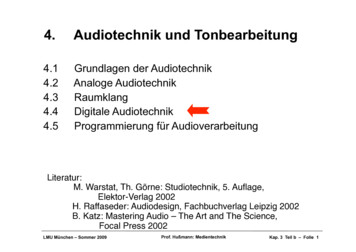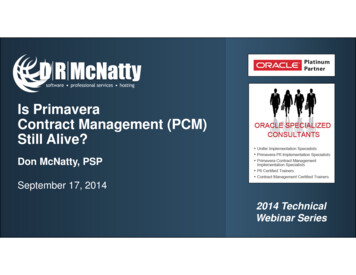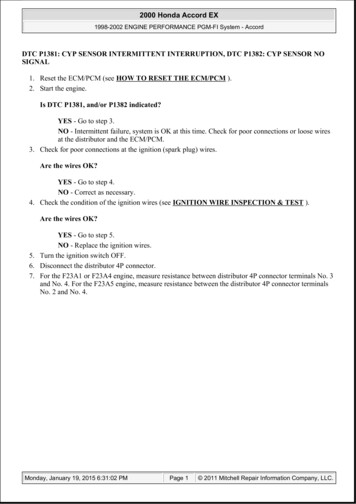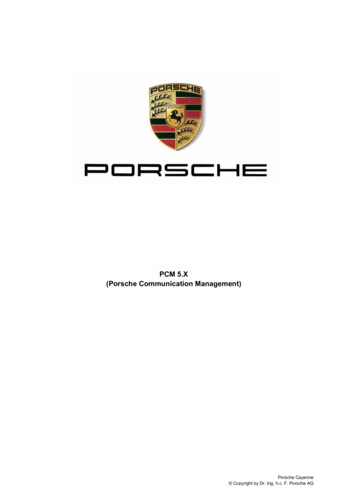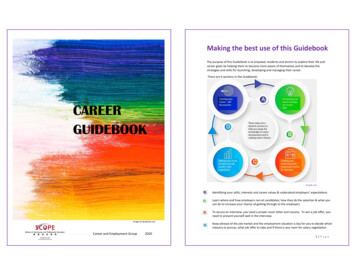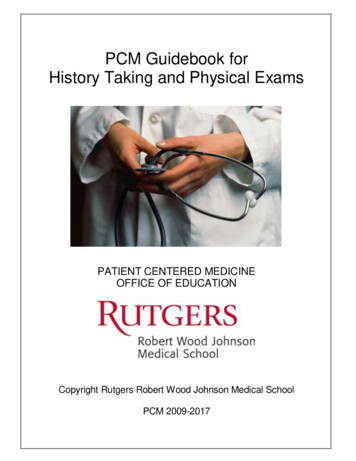
Transcription
PCM Guidebook forHistory Taking and Physical ExamsPATIENT CENTERED MEDICINEOFFICE OF EDUCATIONCopyright Rutgers Robert Wood Johnson Medical SchoolPCM 2009-2017
This guide is designed to provide the followinginformation:SECTIONPAGESThis book was developed by the multidisciplinary steeringcommittee for Patient Centered Medicine. It is meant to be a guidefor your patient encounter. For further detail, please see yourtextbook and speak with your clinical supervisor.How to elicit a Patient Centered Historyand History of the Present IllnessPages 3 -7 The Past Medical HistoryPage 8 The Family HistoryPage 9 The Social HistoryPages 10-20 How to elicit a Review of SystemsPages 21-30How to perform a Physical ExamPages 31–48The Pediatric PatientPages 49–59The Write-upPages 60–67Appendices 1-9 and NotesPages 68-792
HOW TO ELICIT A PATIENT CENTEREDHISTORY AND HISTORY OFTHE PRESENT ILLNESSOpening and facilitating the interview - Key actions1. W ash your hands before and after encounter2. Introduce yourself (state your first and last nameand that you are a medical student) to patient andanyone else who is with the patient. Include whoyou are working with (attending or resident name).3. Address the patient appropriately (use patient’s lastname or preferred name and personal pronoun)Identify patient with first and last name and askhow they would like to be addressed.4. Explain the purpose of the interview5. Offer a social comment or ask a non-clinicalquestion to put patient at ease6. Assure privacy and pull curtains as appropriate7. Assure comfort8. Sit down in a chair if feasible9. Allow the patient to express themself10. A s k i f p a t i e n t h a s a n y q u e s t i o n s a n drespond to questions appropriately11. Adapt your language, pace, and posture inresponse to the patient12. Present yourself professionally both verbally andnonverbally13. Demonstrate empathy, concern, andcompassion3
Closing the Interview – Key actions1. Consider summarizing key history and physical examfindings2. Provide an explanation of what you think is going on– working diagnosis, other possible diagnoses3. Provide specific next steps4. Ask patient/family if they have questions5. Ensure understanding – “teach-back”6. Thank patient.4
Outline for Eliciting Medical HistoryIntroductory DataPatient nameAgePersonal physicianSource of history and estimation of reliabilityHISTORY1. Chief Concern/ComplaintElicit in the patient’s own words, including theduration and elicit why the patient seeks help now(e.g., ”How can I be of help today? What would youlike help with today? or, I understand that you’rehere for Could you tell me more about that?”-“What else?”)2. History of the Present IllnessCharacteristics (OPQRSTU)OnsetPrecipitating, Palliating,PlaceQuality RadiationSeverityTemporalUnderstanding5
ChronologyDate and time of onsetTempo or mode of onset (acute, subacute,gradual)Setting/Context (physical setting, life changes)DurationCourse since onset (stable, intermittent,progressive)Determine if history of similar symptoms inthe pastModifying FactorsPrecipitating and aggravating factorsRelieving factorsEffect of medications or treatment (selfprescribed or by others)Associated SymptomsSymptoms of the same organ systemSymptoms of other organ systemsUnderstanding: Elicit the Patient’s Perspective[SEE APPENDIX 1]1. Assess the patient’s point of view (“explanatorymodel(s) of health & illness”)2. Ask for the patient’s ideas about his/her problem.3. Ask about the patient’s experiences.4. Explore the impact on the patient’s life andpsychosocial context5. Elicit patient-specific requests and goals6. Elicit any hidden fears, concerns, or worries6
ETHNIC: A FRAMEWORK FOR CULTURALLYCOMPETENT CLINICAL PRACTICE[SEE APPENDIX 2]E: ExplanationT: TreatmentH: HealersN: NegotiateI: InterventionC: CollaborationBATHE: A USEFUL MNEMONIC FOR ELICITINGTHE PSYCHOSOCIAL CONTEXT:[SEE APPENDIX 3]B: BackgroundA: AffectT: TroubleH: HandlingE: Empathy7
The Past Medical HistoryGeneral HealthDate of last complete examinationChildhood illnessesAdult illnesses (hypertension, coronary artery disease,hyperlipidemia, diabetes, stroke, chronic lung disease,anemia, blood disorders, depression, present or past useof psychiatric services) Immunizations and datesespecially tetanus booster, pneumovax, influenza, etc.Most recent PPDSurgeries (procedures and dates)TransfusionsTraumaHospitalizations (reason, outcome, dates)Ob-Gyn historyNumber of pregnancies, abortions, miscarriages,complications of pregnancies, living childrenBirth control, last Pap test and results, lastmammogram and resultsDates for menarche, menopauseMedications and AllergiesAll medications with dose, route, frequency, when lasttakenInclude home remedies, borrowed medicines, over thecounter drugs, herbal remedies, othercomplementary/alternative healing modalitiesAcetaminophen, ASA, NSAIDS, birth control pills,vitaminsFor allergies-ask about and document type of reactionReactions to contrast mediaInclude intolerance (nausea, dyspepsia, etc)8
Family History (3 generations)Parents, siblings, children, grandparents, spouse,partner(s)For living-age, healthFor deceased-age, causeInclude genetically significant diseases and chronicillnesses (family history of diabetes,cardiovascular disease, cancer, renaldisease, neuromuscular disease, bleedingdiathesis, psychiatric illness, substanceabuse) and significant communicablediseases (TB,HIV, HEP)Include any appropriate psychosocial or risk factorinformationPrimary decision-maker(s) in familyFAMLIESA USEFUL MNEMONIC FOR ASSESSING THE TYPESOF SUPPORT PROVIDED TO PATIENTS BY THEIRFAMILY MEMBERSF: FinancialA: AdvocacyM: Medical ManagementL: LoveI/E: Information & EducationS: Structural SupportDeveloped by Dr. David Swee, Department of FamilyMedicine and Community Health, Rutgers RWJMS9
Social History (where, with whom, and how a patientlives)Birthplace, significant travel or migrationhistory, and current residenceEducation, occupation, occupational exposures,environmental exposures (home, community),past, current, or futureLifestyle-home situation, social supports,hobbies, petsSocioeconomic issuesTHEESEUS[SEE APPENDIX 4]A MNEMONIC FOR ADDRESSING THE SOCIALDETERMINANTS OF ducationSafetyEconomicsUtilitiesSocial Supports10
Occupational Health Screening QuestionsWhat type of work do you do?Do you think your health problems might berelated to your work?Are your symptoms different at work and athome? Are you currently exposed to chemicals,dusts, metals, radiation, noise or repetitive work?Have you been exposed to chemicals, dusts,metals, radiation, noise or repetitive work in thepast?Are any of your co-workers experiencingsimilar symptoms?If the answers to one or more of thesequestions suggest that a patient's symptomsare job related or that the patient has beenexposed to hazardous material, acomprehensive occupational history should html#afp19980915p935-f111
Relational Status/Sexual History (Note: thissubject will be addressed in greater detailduring PCM 2’s Human Sexuality week):Number of relationships and duration[SEE APPENDIX 5]Sexual history - adapted estions about sexual health should be asked in astraightforward, yet sensitive manner. If you areuncomfortable or believe the patient may feeluncomfortable discussing the sexual history, anexplanation may be helpful. For example, considersaying, “Sexual health is important to overall health;therefore, I always ask patients about it. If it's okaywith you, I'll ask you a few questions about sexualmatters now.” Assurances of confidentiality mayhelp, especially with adolescent patients or patientswith more than one sexual partner.Avoid using terms that make assumptions aboutsexual behavior or orientation. Ask about a patient'ssexual orientation and use the term “partner” ratherthan “boyfriend,” “girlfriend,” “husband,” or “wife.” Askpatients how many partners they have rather thanwhether or not they are married and/ormonogamous. Patients will generally say that theyare married and monogamous, if that is the case,when asked about partners.12
Examples of questions:Are you datinganybody?Are you currently in an intimate relationship?What's your level of commitment to yourpartner? Gender of significant other or partnerAre you sexually active?Do you have sex with men, women, or both?Domestic Violence - when asking, normalize andbe specific: e.g.“Domestic violence has become apublic health epidemic. It is important toask patients about possible violence intheir relationships. Within the past year,have you been kicked, slapped, orotherwise physically hurt by someone?”In taking a sexual history,remember the five “Ps”:PartnersSexual PracticesPast STDsPregnancy history and plansProtection from STDs.13
The following guidelines may be helpful in elicitingconcerns about sexuality or gender identity:Do you have any sexual concerns or questionsyou’d like to discuss?Do you have any concerns or questions about yoursexuality? Sexual identity? Or sexual desires?Are your sexual desires for men, women, or both?Do you feel comfortable with your sexuality andsexual identity?Use language mirroring the patient’s languageSexual OrientationHow do you identify in terms of sexual orientation?Do you think of yourself as:o Lesbian, gay or homosexualo Straight or heterosexualo Bisexualo Something elseo Don’t know14
Are you attracted to/Have you had sexual contactwith:Men W omen Transgender MenTransgender W omen AnotherGender Identity“In addition to sexual orientation, I also talk to all mypatients about gender identity. Do you know what Imean by that?”“Some people may feel like their physical bodies donot match with the gender they most identify. Forexample, a biological male may identify as awoman. Knowing your gender identity also will allowme to care best for you.”SEE APPENDIX 5 for follow-up gender identityquestions15
Military Service HistoryTell me about your military experienceWhen and where do you / did you serve? W hatdo you / did you do while in the service? Howhas military service affected you?If yes to above, obtain more detailed military healthhistory (http://www.va.gov/oaa/pocketcard/)WARRIORS [SEE APPENDIX 6]W - W ar and Military ExperienceA - AffectR - RelationshipsR - Risk Factors and ResponsesI - Injuries/Illnesses/Injustices ExperiencedO - Opportunities and Challenges FacedR - Resources, Supports, and InterventionsS - Service Delivery ExperiencesDeveloped: Robert C. Like, MD, MS,Department of Family Medicine and CommunityHealth, Rutgers RWJMS16
Habits – Health Promotion andDisease PreventionWhat do you do to stay healthy and well? Whatbehavioral risk factors do you have?Exercise e.g. “What is the most physically active thingyou do in the course of a day? What physicalactivities do you enjoy and how often do you dothem?”Diet (restrictions, consumption of fast foods,attentiveness to labels on foods, calciumintake, caffeinated beverages)Sleep (is patient getting sufficient sleep? Is thedifficulty initiating or maintaining sleep?Daytime sleepiness? Snoring?Tobacco (past or present, when started and quit, howmany packs per day, chewing tobacco)Alcohol consumption (drinks per day, thebeverage); present and past useIllicit Drugs marijuana, heroin, cocaine, etc;present and past useScreening for alcohol problemsCAGE mnemonicHave you ever felt you should Cut down?Have people Annoyed you by criticizing your drinking?Have you ever felt Guilty about your drinking?Have you ever needed an Eye-opener (first drink inmorning to steady nerves or get rid of hangover)17
Functional Status Assessment [SEE APPENDIX 7]Are there any physical, behavioral, or developmentaldisabilities?ADL’s (activities of daily living) are basic activitiessuch as bathing and showering, personal hygieneand grooming, dressing, toilet hygiene, functionalmobility (e.g., transferring, walking, moving from oneplace to another, and self-feedingIADL’s (instrumental ADL’s) are more complextasks requiring a combination of physical andmental function such as using the telephone,preparing meals, arranging transportation,managing financesAny other mobility or functional challenges?Patient Engagement (SEE APPENDIX 8)Health Confidence: How confident are you that you cancontrol and manage most of your health problems?(rating scale 1-10)Health Information: How understandable and useful is theinformation your doctors or nurses have given you about yourhealth problems or concerns? (rating scale 1-10).18
Communication Needs Assessment:Health Literacy/Language/DisabilitiesHow comfortable are you with your ability to read, write,and/or understand documents?Health Literacy AssessmentSingle Item Literacy Screener (SILS):“How often do you need to have someonehelp you when you read instructions,pamphlets, or other written material fromyour doctor or pharmacy?”“How comfortable do you feel with yourability to read?What is your primary or preferred language?What languages are spoken at home?Any special communication needs? (e.g., vision,hearing, kinesthetic, or other sensory challenges)Any other intellectual or cognitive challenges?Socio-Cultural HistoryHow would you self-identify in terms of yourethnicity/race/socio-cultural background?Birthplace/Country or State of Origin?Migration history?Any immigrant/refugee experiences?How was/is information about health, illness, andwellness communicated in your family and community?19
Health promotion/disease prevention/wellnessbehaviors?What were your health and illness seeking behaviors?Any use of alternative/complementary medicine or folkhealers?Spiritual HistoryFaith and beliefImportance and influenceMember of groupWishes regarding palliative and end of lifecare/resuscitationMnemonics for taking a spiritual history:FICA mnemonicF: Faith & BeliefI: ImportanceC: CommunityA: Address in /4966.htmlHOPE mnemonicH: Sources of hopeO: Organized religionP: Personal spirituality & practicesE: Effects on medical care and /81.html)20
How to Elicit aReview of Systems (ROS)The purpose of the Review of Systems is to pursuesymptoms which may be related to an undetermineddisease. It serves to remind patients of symptomswhich they may have forgotten and to allow thephysician to systematically review each organ system sothat no significant symptoms will be overlooked. Someparts of the Review of Symptoms may be moreappropriately elicited when determining the history of thepresent illness. The following list gives both the layterms and the medical terms which should be usedwhen completing the write-up. This list is not meant tobe all-inclusive. A head to toe approach is used.A good way to begin the ROS is to ask the patient,“How would you rate your overall health?”(rating scale: Excellent, Very Good, Good, Fair, Poor)21
General HealthEnergy levelWeight loss or gainChange in appetiteMalaiseChills/fevers/sweatsEnvironmental allergiesSkinRash (exanthem)Itching (pruritis)SweatingChange in skin color (hyper or hypopigmentation,yellow color-jaundice)Change in hair texture or growth patternChanges in nailsLesions or ulcerationsChanges in moles, birthmarks or spots on bodyRed, scaly crusted areas, which do not healHistory of skin cancerHeadHeadache (include associated neurologicSymptoms; diurnal timing; positional nature)Head injuryFacial painSinus infections (sinusitis)22
EyesVisual changesCorrective lensesDate of last eye examDouble vision (diplopia)Blurred visionHalosTearing (increased or decreased lacrimation)Inflammation (conjunctivitis)DischargeSpots, flashes (scotomota)Sensitivity to light ssNoise in ear (tinnitus)Ear pain (auralgia)Discharge (blood or pus or other)InfectionsNose and sinusesChange in sense of smell (olfaction)ObstructionDischarge (rhinorrhea)Post-nasal dripNose bleed (epistaxis)23
TraumaPainMouth and throatSore tongueSore gumsBleeding gumsUlcersProblems with dentitionDenturesLast visit to the dentistHoarseness, changes in the voiceSore throatDifficulty swallowing (dysphagia)Pain with swallowing (odynophagia)NeckMassesSwollen glands (enlarged lymph nodes)Limitation of motion, stiffnessThyroid enlargement (goiter)TendernessTrauma24
BreastsKnows self-examLast mammogramTendernessAsymmetryMassNipple dischargeMilky discharge (galactorrhea)Change in sizeRespiratoryPain in chestDifficulty breathing, shortness of breath (dyspnea)define problemCoughSputum production (amount, odor, color, blood(hemoptysis), change in n (location, radiation, with rest or exercise)Shortness of breath related to effort (dyspnea onexertion)Shortness of breath while lying flat (orthopnea)How many pillows used to sleep (e.g. “Two pilloworthopnea”)25
Sudden awakening with shortness of breath(paroxysmal nocturnal dyspnea)Cough-pink or frothyFluttering in chest or awareness of heartbeat(palpitations)Heart rhythm disturbanceBlue lips or nails (cyanosis)Ankle swellingLeg pain on walking (claudication)GastrointestinalAppetite (increased-polyphagia, decreasedanorexia)Difficulty swallowing liquids or solids (dysphagia)Pain on swallowing (odynophagia)Heartburn, burning behind sternum or in throat(pyrosis)NauseaVomiting (amount, blood red (hematemesis), coffeegrounds)Abdominal painDistensionRectal gas (flatus)26
Bowel habitsDiarrheaConstipation/use of laxativesChange in caliberChange in colorBlack tarry (melena)Bright red blood per rectum(hematochezia)Rectal bleeding, itching, hemorrhoidsYellow skin (jaundice)History of hepatitisHistory of ulcersFatty food intoleranceGenitourinaryBurning on urination (dysuria)UrgencyFrequent urination of small amounts (frequency)Frequent urination of large amounts (polyuria)Waking to urinate (nocturia)Difficulty starting streamDecrease in force of stream or dribblingIncontinence (ask about loss of urine on coughingor straining)Flank painSuprapubic painBlood in urine (hematuria)Kidney stonesSwelling in groinTrauma27
More than one attack per year of bladder infectionFemale GenitaliaLesionsItching (pruritis)DischargePain on intercourse (dyspareunia)Male genitaliaLesionsDischargeImpotencePenile painScrotal massesTesticular massesProstate problemsMusculoskeletalPain in joints (arthralgia)Inflamed joints, swelling, increased heat in joints(arthritis)-W hich jointsJoint stiffness (morning stiffness or with activity)Migratory joint painsLimitation of joint motionBack painNeck painMuscle pain (myalgias)Muscle weakness (group of muscles or generalize)Loss of muscle mass (atrophy)28
Bone painFracturesProblems with gaitAbility to perform activities of daily living, otherlimitationsPeripheral VascularPain or cramping in legs, calves, thighs or hips whilewalking (claudication)Swelling of legs or anklesVaricose veinsCoolness of extremityExtremity hair lossDiscoloration of extremityNeurologicChange in memoryChange in thinkingDisturbance in motor function (weakness, paralysis,poor coordination, tremors, involuntary movements)Disturbance in sensory functionLoss of sensation (anesthesia)Diminished sensation (hypesthesia)Strange sensation, tingling, burning(paresthesia) Increasedsensation (hyperesthesia) Disturbances oftaste, hearing, vision, smell Disturbance ofconsciousness (loss ofconsciousness, syncope, confusion)29
Disturbance of equilibrium, balance (ataxia)Inability to speak (aphasia)Difficulty with articulation (dysarthria)SeizuresSpinning sensation (vertigo)Dizziness, lightheadednessPassing out (syncope)Endocrine/MetabolicHigh blood sugar (hyperglycemia)Increased thirst (polydipsia)Large volume of urine (polyuria)Intolerance to heat or coldExcessive sweatingLoss of hair or increased hairinessChange in skin texture, drynessIncreased body fat, thin armsChange in glove sizeLoss or gain of weightDiminution in menses or irregular mensesRecurrent bone fracturesHematopoietic and lymphaticHistory of blood transfusionPaleness“Low blood” (anemia)Weakness or breathlessnessBlood lossHeavy menstrual bleeding30
Easy bruising or bleedingBleeding gumsEnlarged lymph nodesRepeated episodes of jaundicePsychiatricMood, affect, suicidal ideation/intent, psychoticsymptoms (e.g., thought or sensory disturbances)THE PERFORMANCE OF THE PHYSICALEXAMINATION OF THE ADULTThe written physical exam sequence follows a conventionalorder (see end of this book), but the actual physicalexamination may be performed with multiple sequencesdepending upon the clinical situation, context, and venue.The general principle is to develop your own approach, theone with which you are the most comfortable and the onethat minimizes patient position changes. Ensuring comfortand patient privacy and communicating what you are doingto the patient are paramount.Principles of Draping Patients for Physical Examshttps://www.youtube.com/watch?v Q6oCdxISRCEPay attention to the following 10 principles:consent, privacy, exposure, security, control, comfort,warmth, cultural considerations, age & gender, respect31
Here are several important tips: Always wash your hands before examining the patient. Explain what you are going to do and ask for permissionto proceed with the physical exam. Briefly preface eachpart of the exam. Try to do as much of your exam as possible standing onthe patient's right side. Use touch appropriately - a hand on the patient'sshoulder while auscultating the heart can make thepatient feel more comfortable. Be cognizant that your body parts are not inadvertentlytouching the patient. Maintain appropriate eye contact to assess for patientpain or discomfort during the exam. Do not take the patient’s clothes/gown off, ask them todo it. You can offer to assist them in retying the gownafter the exam is completed. Female patients should lift their left breast if you need toexamine the PMI. For breast exams, one side should be draped while theother side is examined. The only time both sides shouldbe simultaneously undraped is if you are specificallyexamining for symmetry. If a patient is wearing a gown and you need to examinethe abdomen, it is more practical to drape the pelvis andbring the gown up (instead of draping the chest andbringing the gown down). For pelvic exams, the patient should be fully gowned(with the gown extending as distally down the thighs aswill allow for a comprehensive exam).32
The following is a suggested sequence when you encountera patient lying supine in bedPatient lying supine in bedGeneral appearanceFacial expressionVital signs- (Use correct cuff size for bloodpressure)Palpate blood pressure right armAuscultate blood pressure right armAuscultate blood pressure left armPatient sitting up in bedOrthostatic vital signsOrthostatic changes left armPatient sitting with legs dangling offside of bedVital signsRadial pulse for rate and regularityRespiratory rate and patternHeadInspect cranium (frontal, temporal, parietal, occipital) fordepressionPalpate craniumInspect hairPalpate hairInspect scalp33
FaceInspect faceInspect skin on faceEyesVisual acuity both eyes (pocket Snellen’s Chart)Inspection of external eye structuresVisual fields both eyesEye alignment both eyesPupillary response to light both eyesExtraocular muscle function both eyesTest for convergenceOphthalmoscopic examination both eyesEarsInspect external ear structures both sidesPalpate external ear structures both sidesCheck auditory acuity both sidesPerform Rinne’s test both sidesPerform W eber’s testPerform otoscopic examination both sidesInspect external canal both sidesInspect tympanic membrane both sidesNoseInspect nosePalpate nasal skeletonPalpate frontal ethmoid and maxillary sinuses both sides34
Inspect nasal septum both sidesInspect turbinates both sidesTest olfactory nerve function (this will not typically bepart of routine testing)MouthInspect outer and inner surfaces of lipsInspect buccal mucosaInspect gingivaeInspect teethObserve Stenson’s and W harton’s ductsInspect hard palateInspect soft palateInspect tongueTest hypoglossal nerve functionInspect floor of mouthPalpate floor of mouthPalpate tongueInspect tonsils both sidesInspect posterior pharyngeal wallObserve uvula as patient says “Ah”Test gag reflexRemainder of Cranial Nerve exam should be done as partof the Neurologic Exam.35
NeckInspect neck both sidesPalpate neck both sidesEvaluate position of tracheaPalpate lymph nodes of head and neck(occipital, posterior auricular, posteriorcervical, superficial and deep cervical,tonsillar, submaxillary, submental, anterior auricular)Palpate thyroid gland by anterior approachNeckPalpate thyroid gland by posterior approachPalpate supraclavicular lymph nodes both sidesPosterior chestInspect backPalpate back for tenderness on vertebralcolumn and both sidesTest for costovertebral angle tendernessEvaluate chest excursion both sidesTest for tactile fremitus both sidesPercuss posterior chest both sidesEvaluate diaphragmatic excursion right sideAuscultate posterior chest to mid-axillary line both sides36
SacrumTest for edemaTest for sacroiliac joint tendernessAnterior chestInspect postureInspect configuration of the chest (sternum, ribs)Inspect chest both sidesTest for tactile fremitus both sidesAuscultate anterior chest both sidesFemale Breast (dune under supervision)Inspect breasts, both sidesInspect breasts during maneuvers to tense pectoralmusclesHeart (sitting)Inspect for abnormal chest movementsPalpate for point of maximal impulsePalpate heart - all four positionaortic, pulmonic, tricuspid, mitralAuscultate for heart sounds, all four positionsAxilla sidesInspect axilla both sidesPalpate axilla both sidesPalpate for axillary lymph nodes both sides37
Patient leaning forwardHeart (leaning forward)Auscultate with diaphragm at cardiac basePatient lying supine with head of bed at 30 Neck vesselsInspect jugular waveform right sideAuscultate carotid artery both sidesPalpate carotid artery-each side separatelyBreasts-male and femaleInspect breasts both sidesPalpate breasts both sides(Position arm at side and arm over head)Palpate subareolar area both sidesPalpate nipple both sidesChest (if already examined when patient is sitting up,no need to repeat)Inspect chest both sidesEvaluate chest excursion both sidesPalpate for tactile fremitus both sidesPercuss chest both sidesAuscultate breath sounds both sides38
HeartInspect for movementsPalpate for localized motion all four positionsPalpate for generalized motion all four positionsPalpate for thrills all four positionsAuscultate heart sounds all four positionsTime heart sounds to carotid pulsePatient lying on left sideHeartAuscultate with bell at cardiac apexPatient lying supine with bed flatAbdomenInspect contour of abdomenInspect skin of abdomenInspect for hernias, palpate inguinal and femoral areafor hernia and lymph nodesAuscultate abdomen for bowel sounds one quadrantAuscultate abdomen for bruits (aortic & renal)Percuss abdomen all quadrantsPercuss liverPercuss spleenPalpate abdomen lightly all quadrants (tenderness,rigidity)Palpate abdomen deeply all quadrants (masses, organsize)Palpate liverPalpate spleen39
Test superficial abdominal reflexAssess for peritoneal signs: should be assessed bypercussion followed by another maneuver such as alight rocking or asking patient to coughCheck for hepatic tendernessEvaluate hepatojugular reflexCheck for shifting dullness if ascites suspectedPulsesPalpate radial pulse both sidesPalpate brachial pulse both sidesPalpate femoral pulse both sidesPalpate popliteal pulse both sidesPalpate dorsalis pedis pulse both sidesPalpate posterior tibial pulse both sidesTime radial and femoral pulse both sidesPatient sitting on bed with legs off sideMental Status Exam Mental Status (Many elements assessed during thecourse of the interview and the physical exam) Marked by a sentence or two signaling a shift fromthe H&P, “Now, I’d like to ask you a series ofquestions which will help me further evaluate yourthinking, memory and mood.” Mental status describes sum total of examiner’sobservations Can change from hour to hour “Slice of time”40
A comprehensive mental status exam is comprised ofseveral parts. A mnemonic that can help you rememberthe exam is ABC STAMP LICK (adapted from Robinson,D.J. (1997). Brain calipers: A guide to a successful mentalstatus exam. London, Ontario: Canada. Rapid PsychlerPress.)ABCSTAAppearance1. Overall gestalt: W hat impression does the patientmake?2. Note particular aspects of appearance(grooming, dress)Behavior/Psychomotor activity1. Note nonverbal behavior during the exam2. Note behavior/attitude toward the examCooperationTake note if/how cooperative patient isSpeech and LanguageEvaluate stream of speech and comprehensionThought process/contentSuicidal Ideation (SI)? Homicidal Ideation (HI)?Delusions?AffectEvaluate affect (affect quality is your impression onhow he/she feels).41
MPLICKMoodEvaluate mood (ask patient to rate on scale of 110).PerceptionsIs the patient experiencing hallucinations? illusions?Level of consciousnessEvaluate orientation to person, place and timeInsight1. Assess “good” versus “limited”Cognitive (Higher Order) Functioning1. Assess recent and remote memory2. Assess attention3. Assess judgment4. Assess abstract thought, calculation ability, objectrecognition, praxisKnowledge base (Be aware that some questionsmay be culturally biased).Depression Screening [SEE APPENDIX 8]Neurologic:Mental Status Exam overlaps with components assessedin Psychiatric Mental Status Exam.Cranial Nerves: Optic, Oculomotor, Trochlear andAbducens Cranial Nerves assessed in Eyes Exam.Assess muscles of mastication and forehead/maxillaryperioral/chin regions for sensation (trigeminal). Assesseyelids closure and smile strength/symmetry (facial).42 pag
name or preferred name and personal pronoun) Identify patient with first and last name and ask how they would like to be addressed. 4. Explain the purpose of the interview 5. Offer a social comment or ask a non-clinical question to put patient at ease 6. Assure privacy and pull curtains as appropriate 7. Assure comfort 8.
